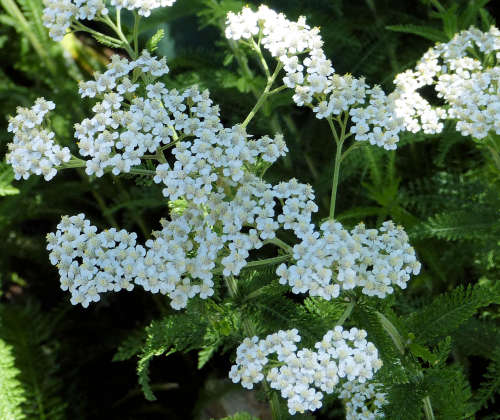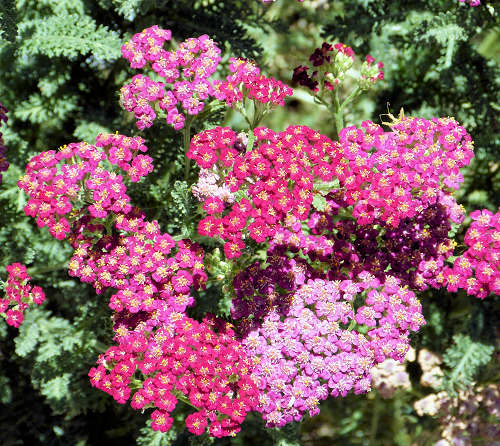Growing Achillea millefolium:
Yarrow
Description
Form: Herb.
Lifespan: Perennial.
Leaf retention: This plant dies to the ground in freezes.
Growth rate: Rapid.
Mature Size: 1-3' (30-100cm) high and 0.5-1.5' (15-46cm) wide.
Flowers: Tiny, in flat clusters, with a variable number of rays, usually white, and pale yellow-white disk florets, mildly fragrant. Many cultivars are available in red, pink, orange and yellow.
Bloom: Spring and summer.
Fruit: Each floret produces a dry fruit with a single seed (cypsela).
Leaves: Green, finely divided, feathery, aromatic.
Stems: Stiff and upright in poor, dry soil. Floppy if the plant is fertilized or grown in moist soil with medium to high organic content.
Roots: Deep, spreading by rhizomes, aggressively invasive in moist soil. The roots accumulate heavy metals, including copper and zinc.
Wildlife: The flowers attract bees, butterflies and other pollinating insects. Yarrow is a larval host plant to several species of moths. It also attracts beneficial insects such as hover flies, ladybugs, and wasps that prey on insects likely to damage garden crops. Some birds use yarrow to line their nests because its chemical compounds inhibit the growth of parasitic insects.
Toxic / Danger: Yarrow is toxic to dogs, cats, and horses. It may rarely cause dermatitis and skin photosensitivity in a few people. While the leaves are considered edible, yellow flowers are poisonous, and no flowers should be consumed by pregnant women.
Origin: Eurasia and North America.
Form: Herb.
Lifespan: Perennial.
Leaf retention: This plant dies to the ground in freezes.
Growth rate: Rapid.
Mature Size: 1-3' (30-100cm) high and 0.5-1.5' (15-46cm) wide.
Flowers: Tiny, in flat clusters, with a variable number of rays, usually white, and pale yellow-white disk florets, mildly fragrant. Many cultivars are available in red, pink, orange and yellow.
Bloom: Spring and summer.
Fruit: Each floret produces a dry fruit with a single seed (cypsela).
Leaves: Green, finely divided, feathery, aromatic.
Stems: Stiff and upright in poor, dry soil. Floppy if the plant is fertilized or grown in moist soil with medium to high organic content.
Roots: Deep, spreading by rhizomes, aggressively invasive in moist soil. The roots accumulate heavy metals, including copper and zinc.
Wildlife: The flowers attract bees, butterflies and other pollinating insects. Yarrow is a larval host plant to several species of moths. It also attracts beneficial insects such as hover flies, ladybugs, and wasps that prey on insects likely to damage garden crops. Some birds use yarrow to line their nests because its chemical compounds inhibit the growth of parasitic insects.
Toxic / Danger: Yarrow is toxic to dogs, cats, and horses. It may rarely cause dermatitis and skin photosensitivity in a few people. While the leaves are considered edible, yellow flowers are poisonous, and no flowers should be consumed by pregnant women.
Origin: Eurasia and North America.
Cultivation and Uses
USDA hardiness zones: 3-9.
Heat tolerant: Yes.
Drought tolerant: Yes.
Sun: Full sun to full shade.
Soil: Well draining, dry, low organic content. This plant is very tolerant of soil types and is salt tolerant. Fertilization is unnecessary and causes rampant growth and invasiveness.
Water after becoming established: Once or twice a month. Overwatering produces lanky, rampant growth.
Mulch: A thin layer of organic mulch is beneficial.
Prune: Deadheading spent flowers prolongs blooming. Remove central stems as they die back. In winter, cut or mow the plant down to its basal leaves before new growth begins. The plant may also be cut back mid-summer to maintain a neater appearance.
Litter: Pruned stalks and flowers, winter dieback.
Propagation: Seed, root division. This plant naturally reseeds if not deadheaded.
Uses: Ornamental, erosion control, ground cover in areas where other plants will not grow, It is also used as a companion plant for food crops in the home garden because it attracts beneficial insects without inhibiting the growth of food plants. The leaves are considered edible, but are bitter and used sparingly. Historically, yarrow has been used to treat battle wounds by coagulating blood and preventing blood loss as well as other medical purposes.
USDA hardiness zones: 3-9.
Heat tolerant: Yes.
Drought tolerant: Yes.
Sun: Full sun to full shade.
Soil: Well draining, dry, low organic content. This plant is very tolerant of soil types and is salt tolerant. Fertilization is unnecessary and causes rampant growth and invasiveness.
Water after becoming established: Once or twice a month. Overwatering produces lanky, rampant growth.
Mulch: A thin layer of organic mulch is beneficial.
Prune: Deadheading spent flowers prolongs blooming. Remove central stems as they die back. In winter, cut or mow the plant down to its basal leaves before new growth begins. The plant may also be cut back mid-summer to maintain a neater appearance.
Litter: Pruned stalks and flowers, winter dieback.
Propagation: Seed, root division. This plant naturally reseeds if not deadheaded.
Uses: Ornamental, erosion control, ground cover in areas where other plants will not grow, It is also used as a companion plant for food crops in the home garden because it attracts beneficial insects without inhibiting the growth of food plants. The leaves are considered edible, but are bitter and used sparingly. Historically, yarrow has been used to treat battle wounds by coagulating blood and preventing blood loss as well as other medical purposes.
Comments
This plant is a member of the Daisy family (Asteraceae).
Do you have additional information or a different experience for these plants that you would like to share? Email info@GardenOracle.com. All contributions are welcome and appreciated.
This plant is a member of the Daisy family (Asteraceae).
Do you have additional information or a different experience for these plants that you would like to share? Email info@GardenOracle.com. All contributions are welcome and appreciated.


Latest update: September, 2024
© 2008-2025 by GardenOracle.com

